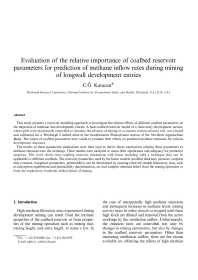Mining Publication: Evaluation of the Relative Importance of Coalbed Reservoir Parameters for Prediction of Methane Inflow Rates During Mining of Longwall Development Entries
Original creation date: September 2008
This study presents a reservoir modeling approach to investigate the relative effects of different coalbed parameters on the migration of methane into development entries. A base coalbed reservoir model of a three-entry development section, where grids were dynamically controlled to simulate the advance of mining at a constant section advance rate, was created and calibrated for a Pittsburgh Coalbed mine in the Southwestern Pennsylvania section of the Northern Appalachian Basin. The values of coalbed parameters were varied to evaluate their effects on predicted methane emissions for various development distances. The results of these parametric simulations were then used to derive linear expressions relating these parameters to methane emissions into the workings. These models were analyzed to assess their significance and adequacy for predictive purposes. This work shows that coupling reservoir simulations with linear modeling yields a technique that can be applicable to different coalbeds. The reservoir parameters used by the linear models (coalbed thickness, pressure, sorption time constant, Langmuir parameters, permeability) can be determined by running relatively simple laboratory tests, such as adsorption equilibrium and permeability determination, on coal samples obtained either from the mining operation or from the exploratory boreholes drilled ahead of mining.
Authors: CÖ Karacan
Peer Reviewed Journal Article - September 2008
NIOSHTIC2 Number: 20034304
Comput Geosci 2008 Sep; 34(9):1093-1114
See Also
- Development and Application of Reservoir Models and Artificial Neural Networks for Optimizing Ventilation Air Requirements in Development Mining of Coal Seams
- Experimental and Modeling Investigation of the Effect of Ventilation on Smoke Rollback in a Mine Entry
- Investigation of Methane Occurrence and Outbursts in the Cote Blanche Domal Salt Mine, Louisiana
- Managing Excess Gas Emissions Associated with Coal Mine Geologic Features
- Methane Content of Gulf Coast Domal Rock Salt
- Modeling and Prediction of Ventilation Methane Emissions of U.S. Longwall Mines Using Supervised Artificial Neural Networks
- Modeling Methane Emissions and Ventilation Needs by Examination of Mining Induced Permeability Changes and Related Damage to Ventilation Controls
- Prediction of Longwall Methane Emissions: An Evaluation of the Influence of Mining Practices on Gas Emissions and Methane Control Systems
- Reservoir Modeling-Based Prediction and Optimization of Ventilation Requirements During Development Mining in Underground Coal Mines
- Reservoir Rock Properties of Coal Measure Strata of the Lower Monongahela Group, Greene County (Southwestern Pennsylvania), from Methane Control and Production Perspectives
- Content source: National Institute for Occupational Safety and Health, Mining Program


 ShareCompartir
ShareCompartir
